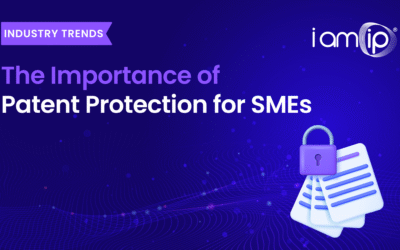
Innovation isn’t an abstract idea, it’s measurable.
And according to data from the European Patent Office (EPO) and the European Union Intellectual Property Office (EUIPO), it’s also one of the most reliable predictors of business success.
In their joint study on intellectual property rights (IPRs) and firm performance, researchers looked at more than 119,000 European companies across every sector and size.
Their conclusion was simple:
Companies that own patents, trademarks, or designs consistently outperform those that don’t, in revenue, wages, and employment.
Owning intellectual property isn’t a bureaucratic step. It’s a growth strategy.
Here’s why, and what businesses can do next to turn IP into lasting competitive advantage:
Innovation That Pays Off
The EPO–EUIPO study examined data from 2019 to 2022 and found that companies with any registered IP right, a patent, trademark, or design generated 23.8% more revenue per employee and paid 22.1% higher wages than those without.
For small and medium-sized enterprises (SMEs), the impact was even stronger. SMEs with IP portfolios produced 44% higher revenue per employee than those with none.Yet fewer than one in ten SMEs in Europe currently hold a registered IP right.
That number should stop every business leader in their tracks.
If IP ownership is so tightly linked to higher productivity, profitability, and wages, why are so many companies still operating without it?
The answer often lies in perception. Many SMEs still view patents as complicated or out of reach, expensive or only for “big tech.” But the data proves otherwise: for growing companies, IP ownership is one of the fastest ways to build resilience and credibility in competitive markets.
Patents as Proof of Serious Innovation
The correlation between IP and success doesn’t end with established companies. It starts right from the beginning.
A separate EPO study found that startups with patents and trademarks are ten times more likely to secure funding than those without. That’s not a coincidence at all, it’s a signal.
Investors read patents as proof. They show that a team is building something unique and defensible. They reduce perceived risk and demonstrate long-term vision.
For founders, patents are more than protection, they are a communication tool that tells the market: “We’re not just innovating, we’re building something that lasts.”
In venture capital, confidence is currency. And patents are one of the strongest currencies a startup can hold.
Beyond Ownership: The Power of Awareness
But here’s the twist: owning IP is only half the battle.
In fast-moving industries like AI, biotech, or clean energy, awareness matters just as much as ownership.
Innovation never happens in isolation. Every new filing sits within a dense network of other patents, prior art, and competing ideas. Without visibility into that network, even well-protected companies can get blindsided. Imagine launching a new product, only to discover six months later that a competitor filed a similar patent in another jurisdiction. Or investing in R&D that overlaps with an already-protected idea because no one spotted the filing in time.
That’s the difference between owning patents and understanding the patent landscape. The companies that consistently outperform don’t just file, they monitor. They track competitor filings in real time, detect early signals of emerging technologies, and identify opportunities where innovation can thrive without infringement risk.
Europe’s IP Moment
The EPO’s findings come at a pivotal time for European innovation. Policymakers are pushing to make Europe more competitive by commercialising innovation, not just creating it.
The Draghi Report (2024) called for a stronger innovation ecosystem that helps ideas move from lab to market faster.
The Unitary Patent, introduced in June 2023, is one major step in that direction, simplifying protection across multiple EU member states and cutting costs for small businesses.
The message from Europe’s institutions is consistent: IP isn’t just a legal formality; it’s a driver of growth and competitiveness.
And yet, the EPO–EUIPO data reveals a paradox: while IP delivers clear advantages, most smaller firms still haven’t adopted it. That’s where technology, and accessible monitoring tools can make a transformative difference.
Bridging the Innovation Gap
So, what can companies actually do?
1. Start Early
Once your technology, process, or brand is unique, file your first patent or trademark. Protecting your IP early builds investor trust and establishes a durable competitive edge.
2. Build Awareness
Use monitoring tools to keep tabs on new filings in your domain. Know who’s innovating around you. Competitors, suppliers, and even customers. This visibility helps you avoid conflicts and adapt faster.
3. Think Beyond Protection
Treat patents as data, not documents. Every filing reveals something about a market trend, a rival’s focus area, or an emerging technology. The right tools can turn that data into actionable insights.
4. Integrate IP into Strategy
Don’t isolate your IP team from your business team. Monitoring insights should feed directly into R&D roadmaps, product strategy, and even marketing narratives. Innovation isn’t just about inventing; it’s about positioning those inventions in a fast-moving competitive space.
The Bigger Picture
The EPO study doesn’t just validate the importance of IP, it quantifies it.
Companies with patents don’t just innovate more; they perform better in measurable, financial terms. Startups with IP don’t just look smarter; they raise more capital and grow faster.
And yet, the message beneath the numbers is even more important: Innovation success depends on visibility.
The firms that thrive are the ones that can see not only what they’ve built, but what’s being built around them.
In that sense, patent monitoring isn’t an administrative tool. It’s a strategic compass. It helps businesses navigate complexity, reduce risk, and stay aligned with where innovation is heading next.
Conclusion – Innovation Is a Moving Target
Patents give companies an edge. Monitoring keeps them from losing it.
The data is clear:
- IP-owning companies earn more
- Startups with IP raise more
- SMEs with IP grow faster
But innovation never stands still. The real winners will be the firms that combine ownership, insight, and agility; using IP not just as protection, but as an engine for smarter decisions.
Owning IP shows where you’ve been. Monitoring it shows where you’re going.
Search
Categories
- Announcement 11
- Case Study 1
- Expert Insights 10
- IamIP News 6
- Industry Trends 31
- Innovation Index 4
- New Release 13
- Platform News 2
- Press Release 1
- Uncategorized 1
- Webinar 16









